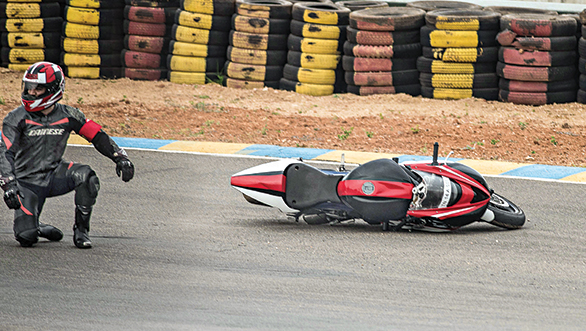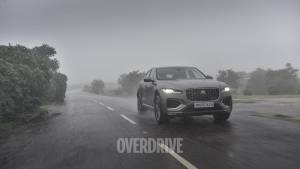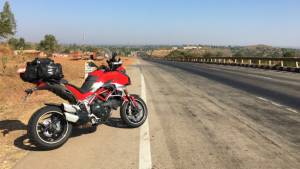Better Riding: To-do list after accidents
It's hard to be orientated and thinking straight after an accident. But trust me it can be done. And there are significant benefits both immediate and long term to be derived from it. My personal method is a to-do list, and I believe if you're a serious motorcyclist, you should have a system you've at least thought about and aim to implement when you crash. The system I use is detailed next, but you should remember that at the racetrack not much of this system applies for the simplest of reasons - I've both medical aid and people I can rely on available within minutes of an incident. Now, here's my system.

Get out of harm's way
For most of us, an accident has a starting point and then a blank state. This blank state is your brain denying you access to sensory input and memory because it believes it might be too traumatic. But if you crash enough, the blank stage diminishes or disappears. And then comes the stage when you're conscious again. And by that I mean awake as well as aware of your surroundings. If you aren't both of those things, it doesn't matter - you need someone else to help you.
As soon as I'm awake and conscious, my first agenda is to see how much risk I am at in the moment. That means scanning quickly to see where I am and what's happening around me. And taking immediate action if needed.
To wit, when I fell of the Ducati, I found myself at the edge of the road where motorcyclists usually filter towards the traffic light ahead. And traffic was moving. So my action was to use the completely normal-feeling right leg to hobble and skip around to the motorcycle and then sit on the footpath placing the bike between me and traffic.
This step also means that if you discover you're at low risk, you could choose to move to the next step instead of having to move.
Turn the machine off
Next, it takes only a moment to turn the machine off if it hasn't already. A range of flammable fluids can leak out of the vehicle in a crash and you don't want live electrical circuits around. If you cannot physically reach it, get someone to do it for you.
Am I okay?
Then comes the turn for a quick self-examination. The first aid course I attended made a massive difference to what I can do if I find someone injured. It also made a difference to how I deal with my injuries. Realisation one is that panic is the enemy and two, there is enough time for you to work through this methodically.
When helping someone, a trained first-aider will run a rapid head-to-toe check for injuries as soon as he's verified that the trio of basics - airway, breathing and circulation (bleeding) - are stable.
If you're on your own, airway and breathing issues, if any, will be instantly obvious. Usually a full-face helmet will prevent or mitigate injuries serious enough to cause these problems. Or, again, you're going to need other people to help you. And fast.
So for yourself, you can immediately focus on what hurts. I will take off any and all clothing in the area that is hurting to see skin. And any areas I cannot see, I will probe with a finger or two to see if there's any bleeding I can't see and feel.
It helps to know that usually a bone breaking comes with chills, profuse sweating, obvious swelling and pain. So if you're not sweating profusely or have the chills, chances are you haven't broken anything. Again in the recent crash, it had a calming effect.
If you want to make doubly sure, examine your gear and go over all the corresponding anatomical areas that show dirt, abrasion or damage. It was when I did this that found a microSD card-sized burn on my elbow.
Home or help
The last step is to decide whether you'd like to head home first or go to a hospital first. This is obviously dependent on your assessment of your injuries.
Clearly, broken bones, serious wounds etc. mean hospital. In my case, I decided I had the luxury of being able to go home first, change out of the gear and then go to the doctor. A call to the doctor helped confirm this decision based on my description of symptoms.
A big consideration here is time. Early diagnoses and treatment cannot be underrated and if you can or think you should, head to the hospital first.
The vehicle
The last consideration is the vehicle itself. If it is rideable, then you have to decide if you're up to making the trip home, or to hospital on it. Chances are bandages at the hospital won't allow you to ride any further - you should have a plan for this.
Calling friends or family is a good idea at this point. They'll be able to chip in with the vehicle as well as with you at the medical facility you're headed to.
And only after you are stable and under treatment should you start the process of dealing with the vehicle. That's the phone call to the road-side assistance people and all of those things.
Who caused the crash?
Notice I haven't even brought up the idea of who or what caused the crash. There is a reason for it. In my book, fighting and screaming obscenities after a crash achieves nothing. It delays help, it delays other people in traffic and it raises your blood pressure. That's it.
Agenda one should always be to protect and help the human beings involved. Then comes the question of who was to blame and who wants to file an FIR and all of that drama. My rule is I've to fix myself first, fix anyone else injured next if I can (or direct help to them), and then worry about bent metal and broken plastic.
Finally, get trained in first aid if you're a serious motorcyclist. WMI-NOLS runs regular, not very expensive, certification-quality programmes that are both fun and educational. Go get trained so that when a crash happens to you, your friend or someone in traffic around you, you already are armed to deal with the situation.
For more Better Riding stories, click here













